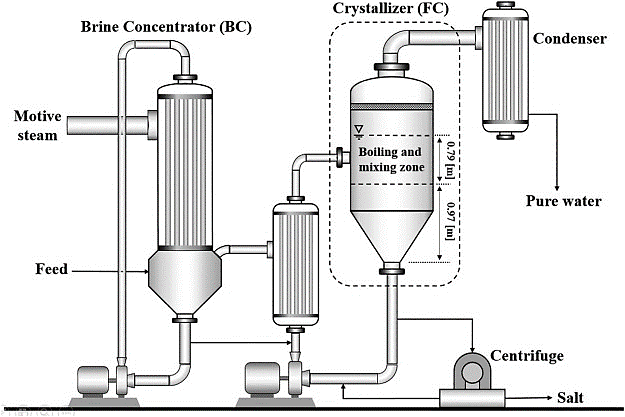
Crystallization is a physical change. Crystallization is the formation of solids from the liquid or gaseous phase. This technique includes obtaining the crystals of a soluble substance from a hot saturated solution and separating the soluble solid from the solution.
To concentrate feed into solid crystals and clean water, crystallizers are used. A progressively harder method for which crystallite sizes are formed from a liquid solution is known as crystallization. Crystallizers can remove liquid wastes completely, resulting in no liquid discharge (ZLD). The process continues and secondary crystallization are the two stages of crystallization. The formation of new crystals is referred to as primary nucleation. Secondary nucleation is the primary stage that results in the mass production of crystals. There are two types of crystallization processes: evaporative crystallization and cooling crystallization.
In 2016, Mi et al.37 regarded the salt accumulation on the photothermal material as a chance to realize ZLD desalination in the photo voltaic still set up. When fifteen wt% pure NaCl aqueous brine was employed as source water, a thick layer of accrued NaCl crystals formed in addition to their two dimensional (2nd) graphene oxide (GO) membrane. The white salt layer significantly lessened light absorption in the system, and triggered a considerable reduction in evaporation level. Having said that, a secure drinking water evaporation charge of 0.five kg m−two h−1 was continue to recorded, indicating the salt precipitation did not block the evaporation. In 2018, a three dimensional (3D) cup-formed photo voltaic evaporator which separated the light adsorption surface area from the salt precipitation floor was noted.
The salts are discharged by opening the flanged cover. The salt basket is ideal for mixed salts with massive crystal salts like sodium sulphate or sodium chloride which have been swiftly dewatered.
Cooling is usually accomplished by making use of the vessel walls, and interior coils, or by flowing the mom liquid by way of an external warmth exchanger.
To understand the water transportation and also the ion concentration distribution in the operation of your crystallizer, the salt ion distribution inside the crystallizer was simulated. The profile structure in the crystallizers was simulated making use of COMSOL Multiphysics application. The effects of the water transportation simulation are shown in Determine 8a. It is evident the brine was swiftly transported from the water transport layer to the photothermal layer. Through brine transportation, brine backflow in addition to diffusion occurred at the same time. Because the inclusion angle in between the photothermal layers turned larger, the diffusion outcome of brine grew to become stronger on the intersection of the photothermal layer and the water transport layer.
The big pore volume of your crust layer would make the offered MgSO4·7H2O not able to thoroughly fill the pore Area Amongst the NaCl crystals, generally preserving ample pore Room available for h2o transport to your evaporation surface area.
Determine 1a presents a schematic diagram on the 3D photo voltaic crystallizer using an open up box structure with just one base closed. The underside and wall from the crystallizer are bi-layered in configuration. The internal layer is usually a commercially out there spectrally selective solar absorber (Alanod®) homogeneously coated on an aluminum sheet and serves as photothermal part. The outer layer of the solar crystallizer is usually a porous and hydrophilic quartz glass fibrous filter membrane (QGF membrane, Merck®) (Fig. S1). The outer QGF membrane, when moist, is specifically trapped onto the bottom from the aluminum sheet via capillary force with none glue. It wicks brine within the resource brine reservoir and permits the brine to spread above the complete outer area during Procedure.
permission is needed to reuse all or Section of the posting published by MDPI, such as figures and tables. For
Thus, in lieu of a single course of action attaining all, It is just a extra appealing and Strength successful technique to to start with use common procedures (e.g., RO and MD) to produce clean water from regular seawater and to focus brines with small concentrations to near saturation, and after that to use the solar driven h2o evaporation Crystallizer Manufacturer Crystallizer For Zero Liquid Discharge System for salts crystallization from the near-saturation brines to obtain ZLD intention.
To focus feed into reliable crystals and thoroughly clean h2o, crystallizers are utilized. A progressively more durable approach for which crystallite dimensions are formed from a liquid Option is called crystallization. Crystallizers can take out liquid wastes totally, leading to no liquid discharge (ZLD).
Veolia is actually a reputable spouse in the development of each and every exclusive undertaking. Combining expert system progress and validation with early scope advancement provides the customer with selections for obtaining both ideal system overall performance and vital organization targets.
MDPI and/or perhaps the editor(s) disclaim obligation for any injuries to people today or property resulting from any Tips, procedures, instructions or items referred to from the content.
We use cookies to help give and enhance our support and tailor written content and ads. By continuing you agree to the usage of cookies.
The entire process of vacuum crystallization consists of a mix of evaporation and cooling when the answer is put less than vacuum conditions, as a result of which the solvent all of a sudden evaporates and cools the solution by means of an adiabatic approach.
In this method, the solutes need to have a melting curve that can decrease in temperature Should the crystallization approach makes use of supersaturation by cooling. The whole process of supersaturation is reached by evaporation of solvent only where the solubility relies on the temperature.